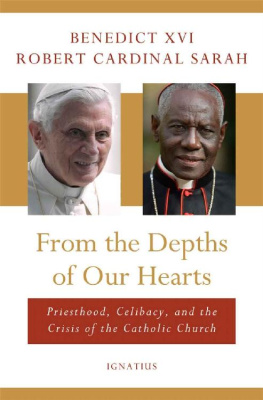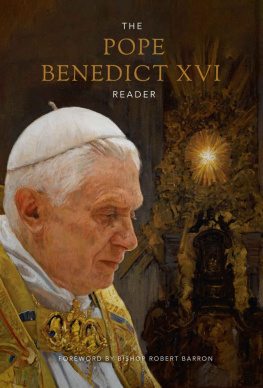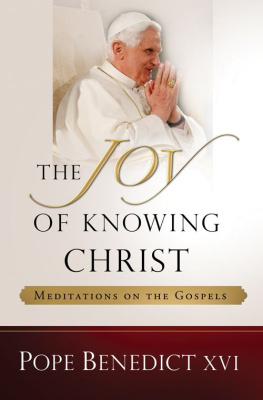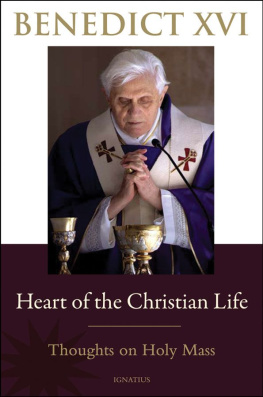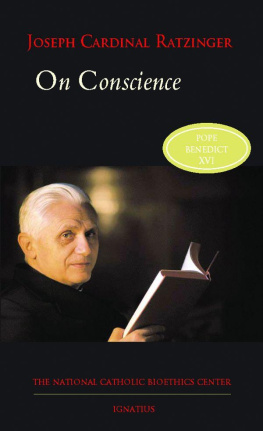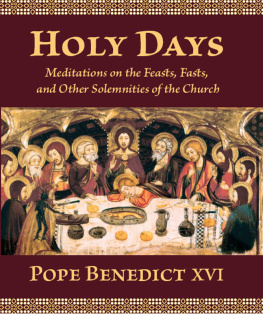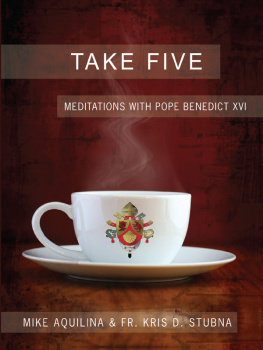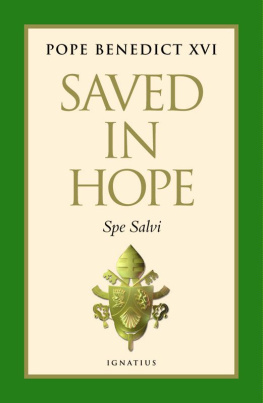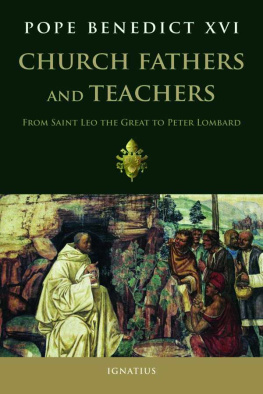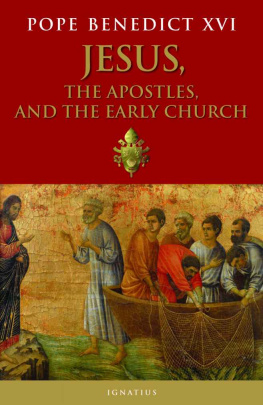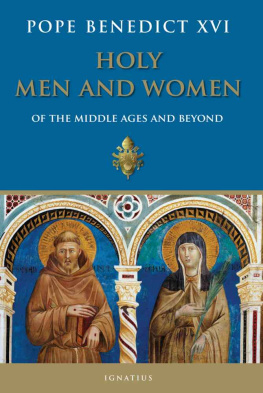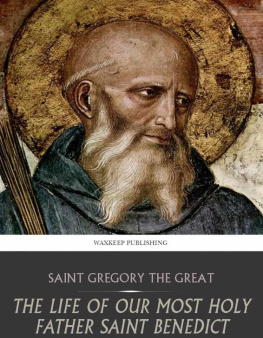Pope Benedict XVI - Holy Women
Here you can read online Pope Benedict XVI - Holy Women full text of the book (entire story) in english for free. Download pdf and epub, get meaning, cover and reviews about this ebook. year: 0, genre: Religion. Description of the work, (preface) as well as reviews are available. Best literature library LitArk.com created for fans of good reading and offers a wide selection of genres:
Romance novel
Science fiction
Adventure
Detective
Science
History
Home and family
Prose
Art
Politics
Computer
Non-fiction
Religion
Business
Children
Humor
Choose a favorite category and find really read worthwhile books. Enjoy immersion in the world of imagination, feel the emotions of the characters or learn something new for yourself, make an fascinating discovery.

- Book:Holy Women
- Author:
- Genre:
- Year:0
- Rating:4 / 5
- Favourites:Add to favourites
- Your mark:
- 80
- 1
- 2
- 3
- 4
- 5
Holy Women: summary, description and annotation
We offer to read an annotation, description, summary or preface (depends on what the author of the book "Holy Women" wrote himself). If you haven't found the necessary information about the book — write in the comments, we will try to find it.
Holy Women — read online for free the complete book (whole text) full work
Below is the text of the book, divided by pages. System saving the place of the last page read, allows you to conveniently read the book "Holy Women" online for free, without having to search again every time where you left off. Put a bookmark, and you can go to the page where you finished reading at any time.
Font size:
Interval:
Bookmark:
POPE BENEDICT XVI
Our Sunday Visitor Publishing Division
Our Sunday Visitor, Inc.
Huntington, Indiana 46750
The Scripture citations contained in this work are taken from the Catholic
Edition of the Revised Standard Version of the Bible (RSV), copyright 1965
and 1966 by the Division of Christian Education of the National Council of
the Churches of Christ in the United States of America.
Used by permission. All rights reserved.
Copyright 2011 by Libreria Editrice Vaticana
Copyright 2011 by Our Sunday Visitor Publishing Division
Our Sunday Visitor, Inc. Published 2011.
16 15 14 13 12 11 1 2 3 4 5 6 7 8 9
ISBN 978-1-61278-510-3 (Inventory No. T1214)
LCCN: 2011930588
Interior design by M. Urgo
Cover design by Lindsey Riesen
Cover art: St. Gertrude the Great
Carrying the Sacred Heart of Jesus (oil on canvas),
by Spanish School (17th century),
Monasterio de Santa Maria de San Salvador,
Canas, Spain / The Bridgeman Art Library
PRINTED IN THE UNITED STATES OF AMERICA
In 1988, on the occasion of the Marian Year, Bl. John Paul II wrote an Apostolic Letter entitled Mulieris Dignitatem on the precious role that women have played and play in the life of the Church. The Church, one reads in it, gives thanks for all the manifestations of the feminine genius which have appeared in the course of history, in the midst of all peoples and nations; she gives thanks for all the charisms that the Holy Spirit distributes to women in the history of the People of God, for all the victories which she owes to their faith, hope, and charity: she gives thanks for all the fruits of feminine holiness (n. 31).
Various female figures stand out for the holiness of their lives and the wealth of their teaching even in those centuries of history that we usually call the Middle Ages. Today I would like to begin to present one of them to you: St. Hildegard of Bingen, who lived in Germany in the twelfth century. She was born in 1098, probably at Bermersheim, Rhineland, not far from Alzey, and died in 1179 at the age of 81, in spite of having always been in poor health. Hildegard belonged to a large noble family and her parents dedicated her to God from birth for his service. At the age of eight she was offered for the religious state (in accordance with the Rule of St. Benedict, chapter 59), and, to ensure that she received an appropriate human and Christian formation, she was entrusted to the care of the consecrated widow Uda of Glklheim and then to Jutta of Spanheim who had taken the veil at the Benedictine Monastery of St. Disibodenberg. A small cloistered womens monastery was developing there that followed the Rule of St. Benedict. Hildegard was clothed by Bishop Otto of Bamberg, and in 1136, upon the death of Mother Jutta who had become the community magistra (Prioress), the sisters chose Hildegard to succeed her. She fulfilled this office making the most of her gifts as a woman of culture and of lofty spirituality, capable of dealing competently with the organizational aspects of cloistered life.
A few years later, partly because of the increasing number of young women who were knocking at the monastery door, Hildegard broke away from the dominating male monastery of St. Disibodenburg with her community, taking it to Bingen, calling it after St. Rupert, and here she spent the rest of her days. Her manner of exercising the ministry of authority is an example for every religious community: she inspired holy emulation in the practice of good to such an extent that, as time was to tell, both the mother and her daughters competed in mutual esteem and in serving each other.
During the years when she was superior of the Monastery of St. Disibodenberg, Hildegard began to dictate the mystical visions that she had been receiving for some time to the monk Volmar, her spiritual director, and to Richardis di Strade, her secretary, a sister of whom she was very fond. As always happens in the life of true mystics, Hildegard too wanted to put herself under the authority of wise people to discern the origin of her visions, fearing that they were the product of illusions and did not come from God. She thus turned to a person who was most highly esteemed in the Church in those times: St. Bernard of Clairvaux. He calmed and encouraged Hildegard. However, in 1147 she received a further, very important approval. Pope Eugene III, who was presiding at a Synod in Trier, read a text dictated by Hildegard presented to him by Archbishop Henry of Mainz. The Pope authorized the mystic to write down her visions and to speak in public. from that moment Hildegards spiritual prestige continued to grow so that her contemporaries called her the Teutonic prophetess. This, dear friends, is the seal of an authentic experience of the Holy Spirit, the source of every charism: the person endowed with supernatural gifts never boasts of them, never flaunts them and, above all, shows complete obedience to the ecclesial authority. Every gift bestowed by the Holy Spirit, is in fact intended for the edification of the Church, and the Church, through her Pastors, recognizes its authenticity.
The person endowed with supernatural gifts never boasts of them, never flaunts them and, above all, shows complete obedience to the ecclesial authority.
This great woman, this prophetess, also speaks with great timeliness to us today, with her courageous ability to discern the signs of the times, her love for creation, her medicine, her poetry, her music, which today has been reconstructed, her love for Christ and for his Church, which was suffering in that period too, wounded also in that time by the sins of both priests and lay people, and far better loved as the Body of Christ. Thus St. Hildegard speaks to us.
St. Hildegard of Bingen, an important female figure of the Middle Ages, was distinguished for her spiritual wisdom and the holiness of her life. Hildegards mystical visions resemble those of the Old Testament prophets: expressing herself in the cultural and religious categories of her time, she interpreted the Sacred Scriptures in the light of God, applying them to the various circumstances of life. Thus all those who heard her felt the need to live a consistent and committed Christian lifestyle. In a letter to St. Bernard, the mystic from the Rhineland confesses: The vision fascinates my whole being: I do not see with the eyes of the body but it appears to me in the spirit of the mysteries.I recognize the deep meaning of what is expounded on in the Psalter, in the Gospels, and in other books, which have been shown to me in the vision. This vision burns like a flame in my breast and in my soul and teaches me to understand the text profoundly (Epistolarium pars prima I-XC: CCCM 91).
Hildegards mystical visions have a rich theological content. They refer to the principal events of salvation history, and use a language for the most part poetic and symbolic. For example, in her best-known work entitled Scivias, that is, You know the ways, she sums up in thirty-five visions the events of the history of salvation from the creation of the world to the end of time. With the characteristic traits of feminine sensitivity, Hildegard develops at the very heart of her work the theme of the mysterious marriage between God and humanity that is brought about in the Incarnation. On the tree of the Cross take place the nuptials of the Son of God with the Church, his Bride, filled with grace and the ability to give new children to God, in the love of the Holy Spirit (cf. Visio tertia: PL 197, 453c).
From these brief references we already see that theology too can receive a special contribution from women because they are able to talk about God and the mysteries of faith using their own particular intelligence and sensitivity. I therefore encourage all those who carry out this service to do it with a profound ecclesial spirit, nourishing their own reflection with prayer and looking to the great riches, not yet fully explored, of the medieval mystic tradition, especially that represented by luminous models such as Hildegard of Bingen.
Font size:
Interval:
Bookmark:
Similar books «Holy Women»
Look at similar books to Holy Women. We have selected literature similar in name and meaning in the hope of providing readers with more options to find new, interesting, not yet read works.
Discussion, reviews of the book Holy Women and just readers' own opinions. Leave your comments, write what you think about the work, its meaning or the main characters. Specify what exactly you liked and what you didn't like, and why you think so.

